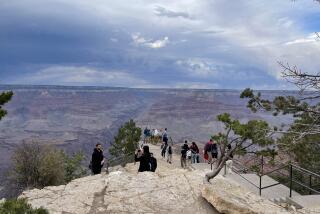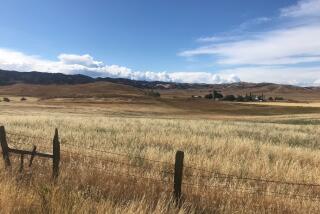Plan to ‘flush’ Grand Canyon stirs concerns
The Grand Canyon is about to take a bath, and National Park Service officials who oversee the natural wonder are worried.
Federal flood control managers, led by Interior Secretary Dirk Kempthorne, this week plan to unleash millions of cubic feet of water from behind Glen Canyon Dam to “flush” the huge canyon bottom with a simulated springtime flood.
Bureau of Reclamation and U.S. Geological Survey specialists say the 60-hour “blowout,” followed by a series of smaller flows this fall, are needed to scour accumulated sand off the Colorado River bottom, then gradually restore sandy beaches and side pools for endangered species and campers.
The flows begin today, and a massive release is set for Wednesday in a media event with Kempthorne.
At its peak volume, 41,500 cubic feet per second of water will burst from tubes at the bottom of the dam, temporarily reducing flows to hydroelectric turbines. The experiment will not affect power or water supplies to customers, officials said.
National park officials said that 10 years of research at a cost of $80 million had shown that the flooding as planned could irreparably harm the national park’s ecology and resources.
Grand Canyon National Park Supt. Steve Martin said he was given a day to formulate comments to a cursory environmental assessment of the project. In those comments, he wrote that statements by the Bureau of Reclamation used to justify the flows’ timing were “unsubstantiated.” Far from restoring crucial sand banks and other areas, the flows could destroy habitat, Martin said.
One flood was not enough, Martin said Monday. Holding off follow-up flows for months would leave endangered humpback chub fish, sandbars used by river rafting trips, and archaeological treasures at river’s edge diminished “almost to the point of no return,” he said.
Martin suggested the timing of the flows served hydroelectric power producers who need peak production during hot summer months.
“The best time to get the most money for your hydropower is during peak energy demands, which is generally daytime hours and generally in the summer,” he said.
The U.S. Geological Survey acknowledged the floods had been timed in part to maximize power generation during peak demand.
Martin said he and his staff had been “assured” this week that they would be allowed to discuss additional releases, including the possibility of flooding during summer months.
Erosion has been a major problem since Glen Canyon was dammed for hydroelec- tric power and water storage in the 1960s. Congress passed the Grand Canyon Preservation Act in 1992 to address ecological problems caused by holding back massive amounts of sediment-laden spring runoff.
The first flush of the Grand Canyon, in 1996, was a mixed success at best, scientists concluded, with some spots more eroded than they were be- fore.
A second flush, in 2004, was slightly more successful, restoring sand and sediment levels about 20 miles downstream of the dam.
“But the river is 250 miles long just in the national park,” said John Hamill, chief of the Grand Canyon monitoring and research center for the geological survey, who has been working with the Bureau of Reclamation to plan the floods. Hamill said changes had been made in the draft document to try to address some of the park service’s concerns. But he said flows would go forward as planned.
“My understanding is the proposal is to still do September and October [releases] for the next five years,” he said. He said the fish would still be helped by flows at that time, and agreed that power-production costs were a prime reason for the timing.
“There’s a fairly significant economic cost to stabilize the flows,” he said. “The peak electrical demand is in the summer . . . and subsides in September and October.”
He said that although park service officials were understandably focused on park issues, the reclamation bureau had to take into account the full picture of dam operation.
Martin said that he did not fault planners for wanting to minimize power losses, and that the dam served valuable multiple roles.
But he said the best, most current scientific data should be used to determine releases.
In a statement, Public Employees for Environmental Responsibility condemned the flush as a “staged canyon greenwash” meant to attract television cameras while following a flood timeline that would “magnify the benefits for power production at the expense of environmental benefits.”
“The Bush administration is trying to extend its control through the term of its successor -- a dead man’s hand throttling the Colorado River management,” said Jeff Ruch, executive director of the environmental group.
More to Read
Sign up for Essential California
The most important California stories and recommendations in your inbox every morning.
You may occasionally receive promotional content from the Los Angeles Times.










